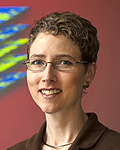Spatial Complexity in Correlated Electronic Systems
Category
Published on
Abstract
Inside conventional materials like metals and semiconductors, electrons are evenly distributed — like liquid filling a container. But electrons inside many quantum materials act more like an exotic gumbo: nanoscale images show that the electrons form complex shapes with interesting textures on scales of multiple lengths.
I will discuss how understanding the formation of these patterns is vital to our understanding of electronic properties and to our eventual technological control of quantum matter. We have defined new paradigms for interpreting and understanding nanoscale electronic textures observed at the surface of these materials by employing theoretical tools from fractal mathematics and disordered statistical mechanics. This new conceptual framework has enabled the discovery of universal, fractal electronic textures across several types of quantum materials.[1-3]
Bio
 Erica W. Carlson is a 150th Anniversary Professor and Professor of Physics and Astronomy at Purdue University. She holds a B.S. in Physics from the California Institute of Technology (1994), as well as a Ph.D. in Physics from the University of California, Los Angeles (2000). A theoretical physicist, Professor Carlson researches electronic phase transitions in novel materials.
Erica W. Carlson is a 150th Anniversary Professor and Professor of Physics and Astronomy at Purdue University. She holds a B.S. in Physics from the California Institute of Technology (1994), as well as a Ph.D. in Physics from the University of California, Los Angeles (2000). A theoretical physicist, Professor Carlson researches electronic phase transitions in novel materials.
Prior to joining the faculty at Purdue in 2003, she did research in theoretical condensed matter physics at Boston University. In 2006, she received the Cottrell Scholar Award for teaching and research. In 2015, she was elected a Fellow of the American Physical Society "for theoretical insights into the critical role of electron nematicity, disorder, and noise in novel phases of strongly correlated electron systems and predicting unique characteristics." Her major contributions have included spin excitations of electronic liquid crystal phases, the prediction of a new phase of matter called a vortex smectic-A, and the discovery of electronic fractals in strongly correlated electronic materials.
Professor Carlson has won numerous teaching awards as a faculty member at Purdue, including the University's highest teaching award, the Charles B. Murphy Outstanding Undergraduate Teaching Award.
Sponsored by
Cite this work
Researchers should cite this work as follows:
Time
Location
Burton Morgan, Room 129, Purdue University, West Lafayette, IN